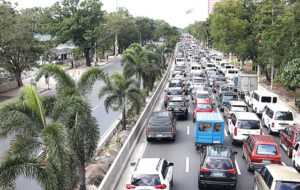A MAN was gasping for air inside a public utility van packed with 20 passengers stuck in traffic on Park Avenue Extension in Pasay City (Metro Manila).
It was 9:45 p.m., November 18, 2015. Twenty-one world leaders were in Manila for the 23rd summit of the Asia-Pacific Economic Cooperation (APEC). Traffic had been on a standstill for hours. Thousands of commuters were stranded on the road. Many decided to walk home.
The man in the van, later identified as Elmer Agaray, 57, of Paliparan III, Dasmariñas City, Cavite, was apparently suffering from cardiac arrest.
Responding village watchman Abubacar Sultan, 29, together with two bystanders, rushed Agaray to the nearest hospital, the San Juan de Dios Hospital along Roxas Boulevard, also in Pasay City.
Only one kilometer lies between the stranded van and the hospital, a distance that could be traversed in four minutes or less sans the traffic jam.
The Pasay City police said Aragay arrived at the hospital after almost an hour, dead.
Dr. Reginaldo Panopio said Agaray died of cardio respiratory arrest. He said Aragay could have been saved had he reached the hospital sooner.
Aragay’s case belied the statement of Transportation Secretary Joseph Emilio Abaya that Metro Manila’s traffic situation “is not fatal.”
What happened to Aragay is an extreme case. But studies reveal that long hours on the road put a lot of pressure on a person’s health.
Data from Numbeo, which collects user-contributed data about cities and countries worldwide, pegs Manila as the fifth city in the world with the worst traffic condition with traffic index pegged at 309.37.
In the top four are Kolkata, India; Mumbai, India; Dhaka, Bangladesh and Nairobi, Kenya.
Traffic Index is a composite index of time consumed in traffic due to job commute, estimation of time consumption dissatisfaction, CO2 consumption estimation in traffic and overall inefficiencies in the traffic system.
Killer traffic fumes
Manila is also fifth in carbon dioxide (CO2) Emission Index, an estimation of CO2 consumption due to traffic time, according to Numbeo.
Livestrong, a health website, says at normal levels, CO2 has no measurable adverse effects on the body, but if one’s breathing is compromised or one is exposed to large amounts of this gas, one can experience a wide range of side effects, including permanent injury and death.
Data from the Department of Environment and Natural Resources’ Environmental Management Bureau (DENR-EMB) reveals worsening air quality in the National Capital Region (NCR).
A 2015 report said the air pollutant concentration in NCR has already reached 130 micrograms per normal cubic meter (µg/Ncm) in terms of total suspended particulates (TSP) from 106 µg/Ncm in 2014. The maximum safe level of air pollutant concentration is only at 90 µg/Ncm.
Air pollution finds its way deep into the hearts and lungs, slowly killing 4.3 million people every year, according to the World Health Organization (WHO).
In the Philippines, the DENR said 12 percent of premature deaths in Metro Manila is caused by poor air quality.
“Air pollution is a major environmental health problem affecting everyone. Whether in Manila, Sao Paolo or London, air pollution is a problem from exhaust fumes from cars, domestic combustion or factory smoke,” WHO said.
Inhalation and ingestion of these pollutants can cause various respiratory and cardiovascular diseases such as asthma, chronic obstructive pulmonary disease, heart disease and stroke.
“Exposure to air pollutants is largely beyond the control of individuals and requires action by public authorities at the national, regional and even international levels,” WHO added.
Stressful commute
People exposed to the daily hassles of traffic jams easily get stressed. This can contribute to health problems such as heart disease, asthma, obesity, aging and gastrointestinal problems, among many others.
Dealing with long queues, competing for a spot in public vehicles, and waiting for traffic to move trigger stress.
A cross-sectional study published in the American Journal of Preventive Medicine in 2012 revealed that the farther people commute, the greater the metabolic and cardiovascular risks are.
A survey among 4,297 adults who had a comprehensive medical examination between 2000 and 2007 showed that those who commute longer have less physical activity, thus register higher blood pressure and body mass index.
Data from the Metro Manila Development Authority (MMDA) shows that daily, about 350,000 people use Epifanio delos Santos Avenue (EDSA).
Former MMDA chairman Francis Tolentino said in an interview that the average speed a motorist can travel along the 23.8 kilometer highway is 26 to 27 kph.
It is not unusual for traffic in Metro Manila to stand still for hours, turning the roads into huge parking lots. A supposedly 20-minute ride from Quezon City to Manila could take more than an hour.
Sitting is the new smoking
Dr. James Levine, director of the Mayo Clinic-Arizona State University Obesity Solutions Initiative, coined the term “sitting is the new smoking.”
He noted that long periods of sitting are more dangerous than smoking, “which kills more people than HIV and is more treacherous than parachuting.”
“[There’s] a growing number of studies that show that prolonged sitting – whether travelling by car, train or bus, at school or work, and watching television – may be associated with increased risk of all-cause mortality, cardiovascular mortality and cardiovascular diseases, and increased risk of diabetes,” said Dr. John Juliard Go, WHO’s national professional officer for road safety and non-communicable diseases.
A 2010 study in the American Journal of Epidemiology found people, regardless of gender, who sat more than six hours a day died earlier than those who sit three hours a day or less.
The researchers surveyed 123,216 individuals – 53,440 men and 69,776 women – who were healthy at the start of the study and over the course of the 14-year follow-up, from 1993 to 2006.
Researchers saw a higher rate of cardiovascular disease mortality among those who sit longer.
(This story was produced under the Bloomberg Initiative Global Road Safety Media Fellowship implemented by the World Health Organization, Department of Transportation and Communications and VERA Files. #SafeRoadsPH )


